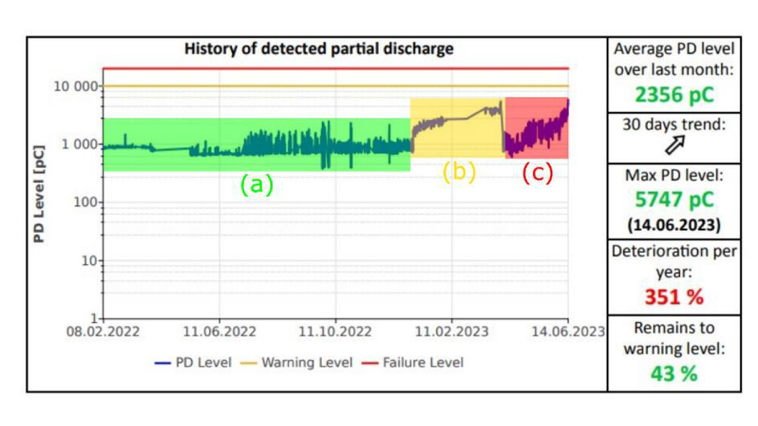Partial Discharge Monitoring at Transformer Station in Poland
We were tasked to provide continous online partial discharge monitoring system, to enhance the safety and reliability of a vital energy distribution point in Poland. Site inspection led us to deploy the PD Doctor system within a 15 kV transformer station, and subsequent to a successful installation, a period of stable discharge activity was observed.
PD Doctor solution allows online monitoring of electrical equipment condition, including subsequent precise and reliable analysis. All information can be reported directly into customers systems or PD Doctor Application (PDDA). PD Doctor is suitable for: cables, cable joints, switchgears, electric motors, transformers, overhead lines, GIS, switchboards and more. System provides increased grids safety and reliability.

Area (a): A close examination of the “History of Detected Partial Discharge” graph revealed valuable insights. While the instantaneous values exhibit general fluctuations, a noteworthy period, spanning from 2/2022 to 1/2023, demonstrated a steady level of discharge activity. This stability signified the normal operation of the line during that time frame.
Area (b): However, a distinct shift occurred between 1/2023 and 4/2023, marked by a significant surge, nearly doubling the discharge activity. Additionally, some data during this period was missing, suggesting possible network manipulations that altered its impedance, subsequently affecting the observed values.
Area (c): Particular attention was drawn to the segment starting in 4/2023, where the activity reverted to its original, long-term level. Yet, it gradually embarked on an exponential rise, ultimately reaching an approximately six-fold value. This pattern is characteristic of an evolving malfunction, a theory corroborated by the PD Response Phase Distribution (PRPD) diagram. Here, alongside normal interference (observed in the lower horizontal section with minor protrusions), two distinct patterns associated with partial discharges, known as “shark’s fins,” became evident.

Conclusion
This fault was subsequently confirmed by the customer using a measuring car and the problematic cable joint was replaced. Immediately after the replacement, the discharge activity disappeared from the PRPD diagram and thus validating the successful repair of the developing fault. Without this intervention, a malfunction and an unplanned outage would have inevitably transpired.
This success story significantly elevated awareness regarding the crucial role of online Partial Discharge monitoring in safeguarding critical assets. As a result, the client is actively planning the future deployment of the PD Doctor system throughout its grid. This proactive approach highlights the lasting impact of our PD monitoring system in preserving the integrity of vital energy distribution points.
